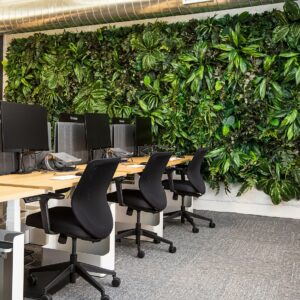Biophilic design – the essential transformation of spaces?
Our environment influences us subconsciously more than we can sometimes imagine. Be it through the people that surround us, the smells or sounds we perceive. Likewise, the design, the architecture of the spaces we live in influences us. Biophilic design aims to create a connection between the spaces we live or work in and nature. The term “biophilia” was first coined by social psychologist Eric Fromm and later popularized by biologist Edward Wilson.
Biophilic literally means “the love of life.” From this definition alone, we can see how important the contact of people with nature is for their well-being. People just don’t like artificial light in a building with no plants, no view, no natural light, Sir Cary Cooper CBE, professor in organizational psychology and health, points out. To encourage just this, companies are now increasingly turning to the still relatively unknown concept of biophilic design. This can be applied in a wide variety of ways. For example, the direct integration of nature can be achieved through plenty of natural light, water, plants, animals and the location in a natural area.
However, the direct experience of nature is not the only part of biophilic design. Also part of this concept is the indirect experience of nature through images, built materials, colors and shapes, which is known as “biomimetic architecture.” Non-visual impressions such as smells or sounds also shape our experience of nature. The goal of biophilic design is to create an inspiring, healthy and functional habitat for humans as biological organisms within a constructed environment.
The benefits of biophilic design
Biophilic design has been shown to have positive influences on psychological and physiological health. Green architecture can reduce stress, improve cognitive abilities and creativity, increase our sense of well-being, and accelerate healing processes. So, since we spend an average of 90% of our time indoors in Europe, it seems only logical to bring nature there as well. Many companies put an increasing focus on improving the health and well-being of their employees and customers. Often, this is attempted through measures such as yoga, meditation, sports or a healthy food offering. Biophilic design does not call for active action, but supports physical and mental health simply by creating a natural work environment.
Due to increasing urbanization, biophilic architecture is becoming more and more attractive. Here, different design elements support different aspects of health. Some help reduce stress, while others promote productivity. According to studies, companies lose billions annually due to absenteeism or lack of efficiency in the workplace caused by stress. Basically, even the presence of animals or a simple walk through the park have tremendous healing effects. A workplace with a view of the garden increases creativity. These phenomena can be traced back to the original or biological connection between humans and nature. Since biophilia has differentiated applications and effects, we also see many meaningful applications in hospitality, office landscapes and retail business. But first things first:
Biophilic philosohpy in hospitality
In  the Hospitality industry, biophilic design can be very influential. It is seen as a cost-effective way to provide a feel-good environment for the guest. This can be applied in a wide variety of settings. Starting with lots of incoming sunlight where possible, using organic materials and shapes, integrating running water or even smells, to setting up a biophilic shower in the hotel industry. Literally at every corner biophilic design can be applied and integrated. In this context, those responsible at the real Group advise a conceptually sensible and planned approach in any case.
the Hospitality industry, biophilic design can be very influential. It is seen as a cost-effective way to provide a feel-good environment for the guest. This can be applied in a wide variety of settings. Starting with lots of incoming sunlight where possible, using organic materials and shapes, integrating running water or even smells, to setting up a biophilic shower in the hotel industry. Literally at every corner biophilic design can be applied and integrated. In this context, those responsible at the real Group advise a conceptually sensible and planned approach in any case.
Keyword hotel industry, especially for travelers the calming effects of biophilic design are impressive. In the study “Human Spaces 2.0: Biophilic Design in the Hospitality Segment” it was found that the length of stay in biophilic hotel lobbies is 36 percent higher than in conventional lobbies and that these are also used 11 percent more. Since biophilia is still not widespread in the hospitality industry today, the marketing and positioning aspect must also be considered. If a unique and memorable experience is offered, this usually leads to hotels receiving more reviews. In addition, price sensitivity decreases. Guests are usually willing to pay more for a room with a view of water or nature than for one without a view. Similar effects are observed with restaurants. On the one hand, guests are offered a more natural, positive atmosphere here; on the other hand, biophilic design is wonderfully suited there to tactically conceal pipes or wiring on ceilings and walls, for example. Important in the context is a sustainable level of automation, which can be achieved best possible with the appropriate irrigation computers.
Biophilia in office landscapes
Office  room furnishings should be comfortable, user-friendly and beneficial for employees, as well as improve productivity and quality of work, if necessary. These factors not only ensure the satisfaction of current employees, but also play a crucial role in the area of employer branding. If positive associations arise when entering a room, this also has an effect on the company’s image. Ecologically connoted furniture, plants or organic partitions are the easiest ways to integrate biophilic design in the workplace. Especially for focused head workers who are forced to concentrate, the stress-reducing and comfort-creating effects of biophilic design benefit. The work climate is often improved, employees get sick less often and work more productively. Companies consequently see fewer sick days and increase their attractiveness in the job market, recognized environmental strategist Bill Browning. Here we also advise viewing the short keynote presentation by Elizabeth C. Nelson.
room furnishings should be comfortable, user-friendly and beneficial for employees, as well as improve productivity and quality of work, if necessary. These factors not only ensure the satisfaction of current employees, but also play a crucial role in the area of employer branding. If positive associations arise when entering a room, this also has an effect on the company’s image. Ecologically connoted furniture, plants or organic partitions are the easiest ways to integrate biophilic design in the workplace. Especially for focused head workers who are forced to concentrate, the stress-reducing and comfort-creating effects of biophilic design benefit. The work climate is often improved, employees get sick less often and work more productively. Companies consequently see fewer sick days and increase their attractiveness in the job market, recognized environmental strategist Bill Browning. Here we also advise viewing the short keynote presentation by Elizabeth C. Nelson.
Retail and biophilic customer experiences
In  the retail business, managers focus on the optimal customer experience. As soon as a store is entered, the pleasant shopping experience starts in the best case. This flatters the customer, creates loyalty and reflects the brand. In addition to the now familiar methods such as integrating organic walls or placing plants, the targeted use or simple letting through of daylight can also have an enormous effect here. Daylight increases the release of serotonin in the brain, which improves mood and reduces stress. Especially men show an increased stress level during shopping, which can be lowered by different biophilic accents. By creating a more pleasant atmosphere, customers spend more time shopping and therefore are in a better buying mood, as reported by Australian environmental scientist Peter Newman. Another benefit of biophilic design for retailers is the change in customer perception. In biophilic environments, products are perceived as being of higher quality. This makes items appear subjectively more interesting and subsequently leads statistically to higher sales figures.
the retail business, managers focus on the optimal customer experience. As soon as a store is entered, the pleasant shopping experience starts in the best case. This flatters the customer, creates loyalty and reflects the brand. In addition to the now familiar methods such as integrating organic walls or placing plants, the targeted use or simple letting through of daylight can also have an enormous effect here. Daylight increases the release of serotonin in the brain, which improves mood and reduces stress. Especially men show an increased stress level during shopping, which can be lowered by different biophilic accents. By creating a more pleasant atmosphere, customers spend more time shopping and therefore are in a better buying mood, as reported by Australian environmental scientist Peter Newman. Another benefit of biophilic design for retailers is the change in customer perception. In biophilic environments, products are perceived as being of higher quality. This makes items appear subjectively more interesting and subsequently leads statistically to higher sales figures.
Biophilia: PR stunt, trend or necessary cultural change?
Biophilic design in a business context sweetens the everyday life of those who work, stay or inquire in such an ambience. Biophilia serves health, increases productivity, brings natural impulses, more positive energy and, in retail and hospitality, increased customer satisfaction. The simply beneficial effects of Biophilic design are omnipresent and increasingly important socially and in the 21st century workplace. The connection between humans and nature is deeply rooted and therefore, in a sense, naturally meaningful. Over the past 250 years, humans have become increasingly removed from nature through urbanization and industrialization. In the coming decades, an estimated 70 percent of the population will live in cities. Reconnecting people with nature and making it possible in everyday activities is now more necessary than ever. Not to mention the business and economic benefits of positive moods, reduced sickness and increased productivity. Please also see our interview in real Talk with Elizabeth C. Nelson and her objective findings.
Image copyright:
Article image: Danist Soh
Image 1: kayleigh harrington
Image 2: Uneebo Office Design
Image 3: Wendy Wei





